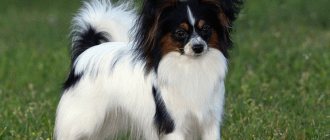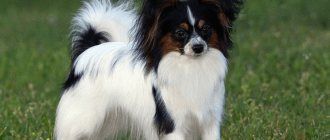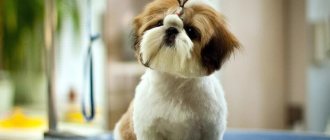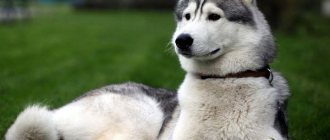- Pets
- >>
- Dog breeds
* Here is a photo of a typical representative of the Papillon dog breed . You can send us photos of your animals by email, and we will post them on the website. Don't forget to send your pet's name.
Other breed names:
Papillon
Video
* We invite you to watch a video about the Papillon . In fact, in front of you is a playlist in which you can select and watch any of 20 videos about a given dog breed by simply clicking on the button in the upper right corner of the window. In addition, the material contains quite a lot of photos. By looking at them you can find out what Papillon looks like.
In this article:
|
Rate the material!
[Total votes: 7 Average: 5]
The Papillon is an unusually attractive creature, as if straight from the pages of a fairy tale book. Such charmers can captivate anyone, it’s not for nothing that at one time they were the favorites of many royalty. Small fur balls with funny ears and lively sparkling eyes simply adore attention and affection, in which they are ready to bathe around the clock.
Papillons are restless and energetic, they are ready to accompany their owner in any adventure. Let's learn more about the origin of these babies by examining their character, habits, preferred menu and features of their content.
History of the origin of Papillons
The homeland of Papillons is France. The name of these dogs is translated as “butterfly”, all because of the unusual and very attractive dog ears, which resemble the outlines of a butterfly’s wings. These dogs are also called continental toy spaniels, which were extremely popular back in the 15th century; the entire Belgian and French elite tried to acquire such a magnificent four-legged furry.
Interesting fact: In the 16th and 17th centuries, Papillons were the so-called social lions and lionesses who accompanied the high-ranking elite at various receptions and took an active part in all kinds of receptions and companies of those years. Even the French king Henry III had an extraordinary love for this dog breed.
Papillons can often be seen in group portraits of that time; they successfully posed for famous artists. Leading a rich social life, butterfly dogs fluttered at balls and various receptions. Surprisingly, some favorites became owners of entire majestic castles. Towards the end of the 19th century, Papillons were brought to America, and in the 20s of the 20th century, interest in these dogs increased among the British.
European breeders wanted to make Papillons even more attractive and irresistible, so they began to experiment by crossing them with Spitz dogs, which is why Papillons became the owners of a magnificent fur coat. In addition, as a result of this selection process, the tip of the dog's tail changed its location, moving to the upper dorsal line.
Papillons were recognized by the English Kennel Club as an independent breed in 1923. And 12 years later they were recognized by the American Cocker Spaniel Club.
What determines the lifespan of a Papillon?
1 year of a dog's life is equal to 1 year of a human's life, but this is not entirely true. The ratios will vary for different breeds. The lifespan of a Papillon depends on the following factors:
- Magnitude. The more massive the animal, the shorter the life expectancy. Organs with a large weight in kg are subject to rapid wear and tear, so they age early. Deterioration of organs causes early death.
- Genetic factors. Any breed of dog is characterized by special diseases. These will be problems with the skeleton, weight, gastrointestinal tract. For example, if your dog develops spine problems, you can adjust his diet and exercise him.
- Diet. It is not advisable to give your Papillon dry food. Dogs whose diet is balanced live longer. Dry food can be used; it will not provide the body with microelements. Take care of food for your pet. This way you will give him microelements, vitamin and mineral components. Do not let your pet gain weight, as this will cause him to develop diabetes, cardiovascular disease, and liver disease.
- Floor. That bitches (female dogs) live 2-3 years longer than dogs (male dogs).
- Castration or sterilization. A castrated/sterilized animal will live 3-5 years longer. The body does not waste energy on reproduction and procreation, which reduces the rate of aging and wear and tear of organs.
- Stress. Don't abandon your dog for too long. When communicating with your pet, focus on being attentive and caring. Do not raise your voice at the Papillon, do not assault him.
- Pregnancy. When breeding puppies, keep in mind that after giving birth, the bitch needs to rest for 6 months. There will be restructuring, strengthening of the body, normalization of hormonal levels, the immune system, and general improvement.
- Lifestyle. If you live in an apartment and not in a house, and you do not have the opportunity to go to the park with your dog for a walk with a leash or harness, then the Papillon is a good option. Think about physical activity for your pet, choose exercises to perform regularly in the morning, afternoon, and evening.
- Prevention of diseases. If your pet has a disease, go to the veterinary clinic. Some owners stall for time, which provokes sad results for the health of the animal.
- Breeding frequency. The more matings the Papillon parents had before conception, the shorter the lifespan.
In French, "papillon" means "butterfly". This is a subspecies of continental toy spaniels with erect ears, soft fur, a small head, and a bushy tail.
With proper care, the dog will live longer. Organize a diet, grooming, necessary physical exercise, and engage in training. Give your Papillon the attention it deserves, do not keep him in an enclosure, so that he feels needed and loved.
Take the Attention Test! Find 10 differences! (click right here!)
Find the answer Are you bothered by some problem or question? Enter “Breed” or “Name of the problem” into the form, press Enter and you will find out everything about the issue that interests you.
Papillon - description of the breed
American breeders subdivide these dogs into Papillons and Phalenes (“mothies”). Phalens are distinguished by the structure of their ears; they have drooping ears. Europeans do not consider moth dogs to be relatives of Papillons, classifying them as a different breed. The Papillon closely resembles a Spitz or a long-haired Chihuahua, although there is no relationship between these dogs.
Papillons are very tiny, their weight varies from 2.5 to 5 kg, although it is not uncommon to find dogs weighing less than 2.5 kg (about that). The standard provides for the height of dogs at the withers, not exceeding 27 - 28 cm.
Interesting fact: The characteristic feature of Papillons is their smile. The presence of a slightly open mouth with a pink tongue in tandem with a brilliant, lively gaze makes the four-legged animals incredibly adorable, looking like plush toys.
Papillons have a head proportional to the entire canine body. Their skull cannot be called too round; it is longer than the muzzle. In smaller representatives of the breed, the feet are clearly expressed, in those that are larger, they are smoothed out. The dog's nose is small, black in color, round in shape, and slightly flattened on top. The nose itself has a flat back.
Papillons have strong, tightly spaced teeth that hide the tongue. If the tongue protrudes beyond the teeth, this is considered a defect. Dog eyes are quite large, almond-shaped, and do not differ in strong convexity. The iris is dark colored.
Naturally, the hallmark of Papillons is their butterfly ears, which have thin but strong cartilage that can hold their ears open. The tips on the ears are not sharp. A dog's ears are set high and raised when the dog is calm. The outer part of the ear is covered with long fur, like a fringe, behind which the ear edge is hidden. On the inside of the ears there is thin, curly hair, often protruding beyond the edges of the auricle.
Papillons have medium-sized necks, the scruff of which is slightly arched. The dog's dorsal part is quite flat without obvious humps and depressions. The loin is prominent, the chest is wide, and has arched ribs. The abdomen and groin area are tightened. Papillons are distinguished by smooth and graceful legs of medium length. The pads on the paws are hard, equipped with strong toes with black claws. For dogs whose feet are painted white, milky white nails are considered acceptable. Often protruding fur is visible between the toes.
The Papillon's tail is set high and has a luxurious dewlap that falls 15 cm down. When the dog moves, the tail is located along the upper dorsal part and can touch it with its tip. If the Papillon is purebred, then its tail will not curl in the shape of a donut and it will not lie completely on its back.
Popular Papillon colors
In general, the fur of Papillons is distinguished by a certain waviness, which is given a noble silky shine, but such a fur coat cannot be called very soft. These dogs have almost no undercoat.
Short hair is present in the area:
- Heads;
- Front part of the front legs;
- Plusen.
The body has longer hair. The presence of feathering on the ears, the inside of the forelimbs, a fluffy collar and bloomers on the hips is welcome. The standard allows all kinds of colors with a predominant white tone of the body and paws.
The most common colors of this breed are:
- Tricolor (tricolor);
- White-sable (sable);
- Bicolor (white-black or white-red).
With the last type of color everything is very clear. But the white-sable color is distinguished by the presence of two colors on one hair. For example, a red hair has a black tip. Red can also vary from light (yellowish) to rich (mahogany). This color is clearly expressed in the area of the ears, where a black border (fringe) is visible against the reddish tone of the ear tissue.
Speaking about the tricolor color, it is worth noting that it is quite controversial, sometimes experts have difficulty defining it. In some dogs, the tricolor is clearly expressed, everything is immediately clear, but sometimes it is minimal or blackened on top; running your hand against the coat, you can see the tan marks only at the very base of the hair.
You can find such a color as the tricolor hound, it is characterized by a sable color in the head area, but there is a spot or several black spots on the body. The standard allows for the presence of mottling in these dogs, but many breeders consider it undesirable, although the speckles sometimes look very elegant.
Character and habits of Papillons
Papillons are good-natured and sympathetic creatures. It seems that they are not in a bad mood at all. Dogs seem to wear rose-colored glasses, being tireless optimists. They find positive nuances in any situation. These four-legged pets are very inquisitive, they can be considered true explorers, because every unnoticed little thing on a walk can cause unprecedented dog interest. Papillons have a fragile and vulnerable soul, so they can fall into a depressed state from rough treatment and pressure from the owner.
Papillons are not characterized by capriciousness. They easily adapt to living in both small apartments and large country houses. Dogs are very loyal with children. Dogs do not perceive strangers as enemies and will not make noise over some nonsense; of course, only well-mannered dogs do this. If the butterfly dog is left at home all alone, then naturally it will miss its family members, but it will never cause destruction in the apartment, so there is no need to worry about damage to property.
Interesting fact: Papillons get along well with other pets, such as the same breed or cats. Experts even recommend getting your dog a friend to ward off boredom when the owner is away.
It should be added that Papillons treat large animals with suspicion and distrust, so it is better not to keep a butterfly dog and, for example, a German shepherd together. There is no need to hurt the delicate and sensitive psyche of sugar daddies (as Papillons are often called).
In general, Papillons are very gentle and, it would seem, are completely unaware of such a concept as aggressiveness. Despite all this, they are ready to protect their family, distinguished by courage and determination. These kids are ready to do a lot for the sake of their beloved owner and other equally adored household members. Surprisingly, if you anger or offend a Papillon, he can become angry and bite his ill-wisher, so these miniature dogs need training and early socialization.
Papillons are cute, mischievous creatures with a cheerful and playful disposition, always ready to have fun with their owner while engaging in active recreation. Good nature, affection and cheerfulness are the traits inherent in this breed; they give the dogs incredible charm, making them the favorites of others.
Jack Russell Terrier
children : not suitable for toddlers, but loves to play with older children, so suitable for boys
allergies : not suitable for people with allergies
apartment : suitable for small apartment
This is a battery-powered dog that will never let you get bored. They are always ready to play and run, but at home they behave calmly. Dogs are attentive and smart, cunning and inquisitive. The Jack Russell doesn't like strangers. He will protect you both on a walk and in the apartment, but is not aggressive, but rather very active. Jack is a good watchdog, despite his small size. Also, the dog cannot resist small animals, rodents and cats. They are prey. And, of course, the most charming feature of the breed is the ability to stand on its hind legs, begging for treats or apologizing for mischief.
Interesting facts about Papillons
By studying and analyzing interesting facts about Papillons, you can learn a lot of fascinating things about the characteristics of this sweetest breed. This will be especially useful for those who are thinking about getting such a furry pet.
Let's try to list the most unusual information about these dogs:
- Surprisingly, Papillons are related to the spaniel breed, this is explained by the fact that butterfly dogs originated from dwarf hunting quadrupeds, widespread in the territories of France and Italy. It’s not for nothing that they are officially called continental toy spaniels;
- Untrained Papillons, although small, can be aggressive;
- Papillons are among the ten smartest dogs in the world, ranking eighth according to the Stanley Coren scale;
- It is believed that these dogs have a human character, they are characterized by the presence of resentment, jealousy, joy and even smiling; all of the above emotions are immediately visible on the Papillon dog’s face;
- It is known from history that Papillons were favored by celebrities and royalty. They were pets of the Marquise de Pompadour, Marie Antoinette, and Louis XIV. Henry III spent a whole third of the state treasury on caring for dogs and purchasing these four-legged animals;
- It is interesting that all Papillons have drooping ears at birth, and they stand up between two and four months of age;
- Papillons love cats, so they can become true friends with them;
- Papillons are miniature owners of a power-hungry disposition; they will be happy to crush any member of their family who has shown weakness towards them. Dogs like to manipulate in this way;
- In the 17th century, artists often depicted Papillons in group portraits.
Papillon
children : very good with children
allergies : dogs rarely cause allergies
apartment : suitable for small apartment conditions
The small fragile dog loves to communicate, sit in your arms and be cuddled. She has no seasonal shedding and almost no dog smell. Dogs are very enthusiastic about the presence of small children, other dogs and even cats, especially if they were raised with them. However, it is worth supervising when playing with your child, because... the dog is very nimble, and some games for it can end in injury. She would never do anything bad, but a child might accidentally harm her.
Pros and cons of Papillons
Surprisingly, even such a cute and charming dog as the Papillon has its drawbacks, however, the breed also has many advantages. Let's try to look at this dog with an unbiased eye in order to characterize all its advantages and disadvantages. Let's start with the positive features.
Pros of the Papillon breed:
- Possessing a developed intellect. The Papillon is so smart and quick-witted that it ranks first among other decorative dogs;
- The dog is easy to learn and happily trains;
- They show boundless loyalty to the owner and household members;
- In the company of members of their family, they can easily adapt to any changes, so they can safely go on a trip with their owners;
- They love to frolic with children, showing them a friendly and always loyal attitude;
- They can make friends with other pets (not too large), giving preference to cats;
- Tendency to show kindness and affection;
- Cheerful and perky disposition, optimistic character.
Disadvantages of Papillons:
- Untrained Papillons can be aggressive and bite, and their teeth are needle-sharp;
- Dogs quickly become attached to a person, then suffer greatly in his absence, so they need to show moderate attention;
- Papillons have a loud bark, which not everyone likes;
- The Papillon coat requires constant and careful care;
- Papillons do not like noise and large crowds of people;
- Dogs require constant companionship to prevent them from becoming depressed;
- The need for training and early socialization;
- They often suffer from obesity, so you need to carefully consider their diet.
Breeding Papillons
The optimal age for mating is considered to be two years of age for Papillons. It is not recommended to breed dogs earlier; this slows down their development and makes their offspring weakened. The main stage here is the selection of healthy partners who do not have hereditary diseases. If any are found, then you can begin the process, which is best started between 9 and 15 days after the female starts estrus.
For confidence and to ensure a successful result, it is recommended to carry out a couple of matings, which need to be arranged on the territory of the male dog, so that he does not get nervous and feels confident and in power. It is worth noting that both Papillons (both male and female) should be moderately well-fed, but not fat. They are dewormed and treated for fleas in advance.
If everything went well, then the female becomes pregnant, which usually goes smoothly, without any problems. At this time, you need to treat the female with care, do not pick her up, and limit excessive activity during walks. Serving sizes should be increased closer to the second half of pregnancy.
Also, special complexes of vitamins and minerals that should be given to the future dog mother will not hurt. For childbirth, you need to prepare a place with clean bedding. The day before this event, the fur on the belly and in the genital area should be trimmed.
A number of important signs indicating the onset of labor:
- The female is very worried, her breathing quickens, she may tremble and hide in corners, or follow her owner;
- In the area of the sides, pits become noticeable due to the lowering of the abdomen;
- Presence of rapid heartbeat;
- Lowering body temperature by a couple of degrees.
The presence of this condition in a dog can last from several hours to a day, then contractions begin. You need to be close to your pet, providing her with support and care. The owner sometimes has to rupture the amniotic sac himself and normalize the puppy’s breathing by removing mucus with a rubber bulb.
It is necessary to lubricate the edges of the umbilical cord with iodine if droplets of blood are visible on it. The babies that are born are placed one by one in a box with a warm heating pad. The box itself should be within the mother dog's field of vision. When the birth has come to an end, you need to change the bedding and transfer the babies to the mother.
Papillon care
In order for a butterfly dog to feel comfortable in a new home, you need to buy all the belongings necessary for its maintenance, which includes a bed with replaceable mattresses, a couple of metal or ceramic bowls, a comb for tidying up its coat, toys (it is better if they are latex ). To walk your animal you need to get a leather collar, leash and tape measure.
It is not recommended to use a harness; it can lead to eversion of bones. It is better to set up a dog’s place away from the radiator, where there are no drafts and there is an excellent view of the space, so that it would be interesting for dad to watch the household. You need to walk your dogs twice a day, for at least 30 minutes, but it can be longer, they obviously won’t mind.
As already mentioned, Papillons do not have an undercoat, so their shedding is not as bad as many people think, only during this period you need to brush your pet daily. The rest of the time, this can be done twice per week. It is worth noting that the fur is combed clean and moisturized; if this is done with dry hair, it will become very brittle. Papillons are often trimmed in certain places, this could be: the body itself, the hair between the toes, the groin and anal areas. Show-class dogs should not be groomed themselves; it is better to take them to specialists.
Papillons should be bathed as the dog gets dirty. It is better to dry the fur coat with a hairdryer, then the hairs will be straight, otherwise they will curl and be difficult to comb. If you don’t have time for regular bathing procedures, you can buy your dog a special overall for walking to protect its fur from dust and other contaminants.
Interesting fact: Papillons themselves are very neat and will not get dirty for no reason; most often, they only need to wash their paws after walks.
Dogs should have their nails trimmed; it is recommended to do this immediately after water treatments, when they (the nails) have steamed and become soft. Sometimes there is no need for such a procedure if the Papillon is walked often and for a long time, then the claws grind down on their own. Dogs are recommended to brush their teeth using a brush and a specialized paste for animals. It is useful to give your furry dogs dog chips, which counteract the formation of tartar. You also need to take care of your dog's ears and eyes. The former are wiped with a napkin soaked in an antiseptic solution (gel), and the latter – with chamomile infusion.
Care
Pets are deprived of undercoat, so shedding does not cause any special problems for the owner. It is necessary to comb once a day when changing coat, at other times - several times a week. To prevent the hairs from breaking, before the procedure they need to be moistened or washed using a special shampoo for dogs.
A haircut simplifies care: you can trim the groin area, body and between the fingers. It is worth bathing when dirty; Drying with a hairdryer is allowed, since the hair that dries on its own curls and becomes difficult to comb.
Papillons are very neat. For walks, especially in cold weather, it is worth buying them a jumpsuit that eliminates the need for too frequent bathing. After each walk, it is enough to wipe your pet’s paws.
It is recommended to trim the claws after a bath: they first soften and become more pliable. The procedure can be omitted if the pet goes on frequent walks for a long time, which naturally causes the claws to wear down.
You should brush your teeth regularly to remove plaque. It is enough to use a regular toothbrush and a special composition. To prevent dental diseases, you can give special dog chips to chew. The eyes are wiped with cotton wool soaked in chamomile infusion, and the ears are cleaned with a cotton swab coated with disinfectant gel.
If the owner notices that the dog is getting ready to do “deeds” on the floor, he must be quickly transferred to the tray without raising his voice or punishment.
Papillon diet
The dog's menu must be balanced, then the daddy feels great, frolics, and his coat exudes shine. Low-calorie food is not suitable for dogs; it can have a negative impact on its development. A high-calorie menu is also dangerous; it can lead animals to obesity. The diet should contain food of both animal and plant origin.
So, Papillons are fed:
- Meat (beef, rabbit, veal), scalded with boiling water;
- Boiled offal;
- Porridge (rice, buckwheat, oatmeal, corn);
- Fermented milk products;
- Boiled sea fish without bones - once a week;
- Egg yolk – once a week;
- Finely chopped raw fruits and vegetables.
Naturally, all products must be fresh; it is useful to treat dogs with unrefined vegetable oil, giving half a tablespoon for several days. This should be done two or three times a year. Papillons have increased bone fragility, so they require calcium. Puppies are given milk diluted with water one to one.
It is useful to add bone meal, milk powder, seaweed powder, and chalk to the main meal. Once a week you can pamper your pet with a sugar bone. In general, small puppies (up to 3 months) are fed 6 to 8 times a day, gradually reducing the number of meals, switching to two meals a day by the age of one year. There is no need to feed your Papillon food from your table; such food will be too fatty, salty, and peppered for him.
You cannot feed dogs:
- Fried and smoked products;
- Tubular bones;
- Sausages;
- Pork;
- Various sweets;
- Baking;
- Cheese;
- Legumes and potatoes;
- River fish.
Carefully monitor the diet, do not let your dog overeat. Feed your butterflies at the same time period; there is no need to distract your pet while he is eating. Immediately after your Papillon has eaten, you should not take him outside; it is better to wait half an hour until everything in his stomach settles down.
Features of care
Despite the relatively long coat length, the dog does not require special care. Brushing twice a week is enough. As for bathing, frequent procedure will not bring any benefit, but will only dry out the skin, so you need to wash your dog only when necessary.
To obtain a beautiful flowing coat, you can choose products not only for washing, but also for making it heavier.
Due to fragile bones, it is recommended that puppies include calcium-rich foods in their diet; however, dogs should not be given food from their table and should give preference to specialized food.
To prevent the ears from getting dirty while eating (if the food is not dry), it is better to lift them with special devices.
When walking during periods of sharp temperature changes (autumn, winter), you can use clothes and protect your paws from chemicals with shoes.
Diseases and health problems
In general, among all decorative breeds, Papillons are considered the strongest and healthiest, but they are not spared from the ailments typical of such dogs.
Furry pets may suffer from:
- Cataracts;
- Retinal atrophy;
- Reversible cough;
- Entropy (inversion) of the century;
- Patella (dislocation of the kneecap);
- Deafness.
Deafness is considered the scourge of this breed; it is most often congenital, and it is completely impossible to cure it. Various viral infections are very dangerous for Papillons; they can easily catch something. In order to prevent this from happening often, the dog must be vaccinated in a timely manner and undergo all routine vaccinations. If a quarantine has been declared in the area where the dog lives, it is better not to take the Papillon out of the house during this period, so as not to risk it.
Important fact: Constant care for your pet and regular hygiene procedures are the key to its healthy, happy and long life. Papillons can live from 14 to 18 years and feel vigorous even in old age.
It is necessary to constantly monitor the dog’s behavior and note any deviations that may indicate any discomfort or illness. When cleaning your eyes and ears, be extremely careful and careful, because Papillons are so sensitive and vulnerable. Proper feeding plays an important role, because excessively large portions can provoke obesity, and with it a number of other ailments.
Do not forget about preventive examinations in a veterinary clinic, which can also prevent the development of many diseases or detect them at the inception stage. In addition to routine vaccination, it is necessary to carry out regular deworming and flea treatment. By following all these simple rules and regulations and loving your pet, you can avoid many diseases, ensuring your Papillon has a cloudless existence.
How to properly care
Despite the fact that continental toy spaniels are long-haired dogs, they do not shed heavily seasonally, which is due to the lack of undercoat.
In general, representatives of this breed do not require labor-intensive care and only need regular hygiene procedures..
Wool and bathing
It is necessary to comb your pet with a metal comb every 2-3 days, and daily during the molting period. This helps prevent tangles, remove dead hair and dust, and improve your dog's blood circulation.
NOTE!
Papillons only need a hygienic grooming, which involves cutting the hair between the pads and around the paws, as well as around the anus and in the groin area.
Dogs should be bathed as needed, but not more than once every 10 days. For washing, you need a shampoo that matches your coat type.
Claws
Trim with a guillotine nail clipper for small breeds 1-2 times a month, smooth the sharp edge with a nail file . It is important to shorten the claws carefully so as not to touch the blood vessels.
Ears
Inspect regularly and wipe the inside of the ear every 7-10 days with a cotton pad soaked in warm boiled water.
Phalenas also require daily ear ventilation.
Teeth
Brush every 2-3 days with a special toothbrush and toothpaste for dogs.
To prevent the formation of plaque, it is necessary to include fresh tomatoes and special chewy treats in your dog’s menu that promote mechanical cleaning of the teeth.
Eyes
Wipe weekly with a damp lint-free cloth soaked in chamomile infusion, tea leaves or simply boiled water.











